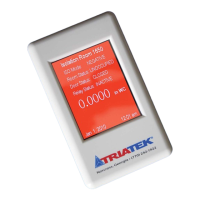SYSTEM SETUP
FMS-1650
TRIATEK reserves the right to change product specifications without notice.
- 30 -
Selecting one of the secondary relay outputs from the Relay Setup
menu invokes the Relay x Trigger Mode configuration popup as shown
in Figure 56. The user may select one of three trigger modes for this
digital output resource: Setpoints, Isolation Mode, or Occupancy Mode.
Currently, the only available option for triggering the relay outputs on
the FMS-1650 is Setpoints Mode. The other two trigger modes will be
made available in a future firmware release.
Once Setpoints Mode is selected as the trigger mode for the relay
output, the user is prompted to select one of the four universal analog
inputs or one of the two dedicated thermistor inputs as the input
channel. While the default setting for the relay outputs is a one-to-
one mapping, this selection allows the relay output to be remapped
to any one of the analog input resources. For example, if one of the
secondary relay outputs is to be used to control a strip heater in a
temperature control application, then that relay should be remapped to
the thermistor input that monitors the room temperature.
After selecting the input channel, clicking Next advances to the Relay
x High Setpoint entry screen, where the user may specify the threshold
above which the relay gets activated, or deactivated if in reverse acting
mode. After entering the high setpoint, clicking Next advances to the
Relay x Low Setpoint entry screen, where the user is prompted for
the threshold below which the relay gets deactivated, or activated if in
reverse acting mode.
After specifying the high and low setpoints, the user is prompted for the
acting mode and delay associated with the relay output (Figure 55). In
direct acting mode, the relay output will be activated when the sensor
input exceeds the high setpoint, and will be deactivated when the
sensor input falls below the low setpoint.
In reverse acting mode, the relay output will be deactivated when the
sensor input exceeds the high setpoint, and will be activated when the
sensor input falls below the low setpoint. The relay output delay may
be up to 180 seconds, or three minutes, in duration.
If Isolation Mode is selected as the trigger mode for the relay output,
the user is next prompted to select whether the relay output should
activated or deactivated for each mode of isolation. Next, the user is
prompted for the acting mode and delay to be associated with the relay
output.
If Occupancy Mode is selected as the trigger mode for the relay output,
the user is next prompted to select whether the relay output should
activated or deactivated for the two states of occupancy. Next, the
user is prompted for the acting mode and delay to be associated with
the relay output.
The next section discusses the options available on the PID Loop
Setup menu and the configuration of the secondary PID loops on the
FMS-1650.
Figure 55. The action
mode and delay time
for secondary relays
may be configured at
this popup screen.
Figure 56. Secondary
relay outputs may be
triggered in one of
three modes, with the
default being Setpoints
mode.
Confi guring Secondary Relay Outputs

